The Impact of the Russian War against Ukraine on the German Hydrogen Discourse
Abstract
1. Introduction
2. The German Hydrogen Discourse and the German Dependence on Russian Fossil Fuels
3. Discourse Analysis: Data and Methods
3.1. Discourse Data
3.2. Preprocessing Text Data
3.3. Structural Topic Models (STMs)
4. Results
4.1. Topics of the German Hydrogen Discourse
4.2. Topical Prevalence Contrast
4.3. Topic Dynamics
5. Discussion
5.1. Shift of Discourse from Sustainability Considerations to Securing Energy Supplies
5.2. External Dimension of Hydrogen Policy—New Energy Trade Partners
5.3. The War as a Driver for the Hydrogen Innovation Process—The Discourse on LNG Terminals and the Focus on Infrastructure
6. Conclusions
Author Contributions
Funding
Institutional Review Board Statement
Informed Consent Statement
Data Availability Statement
Conflicts of Interest
Appendix A
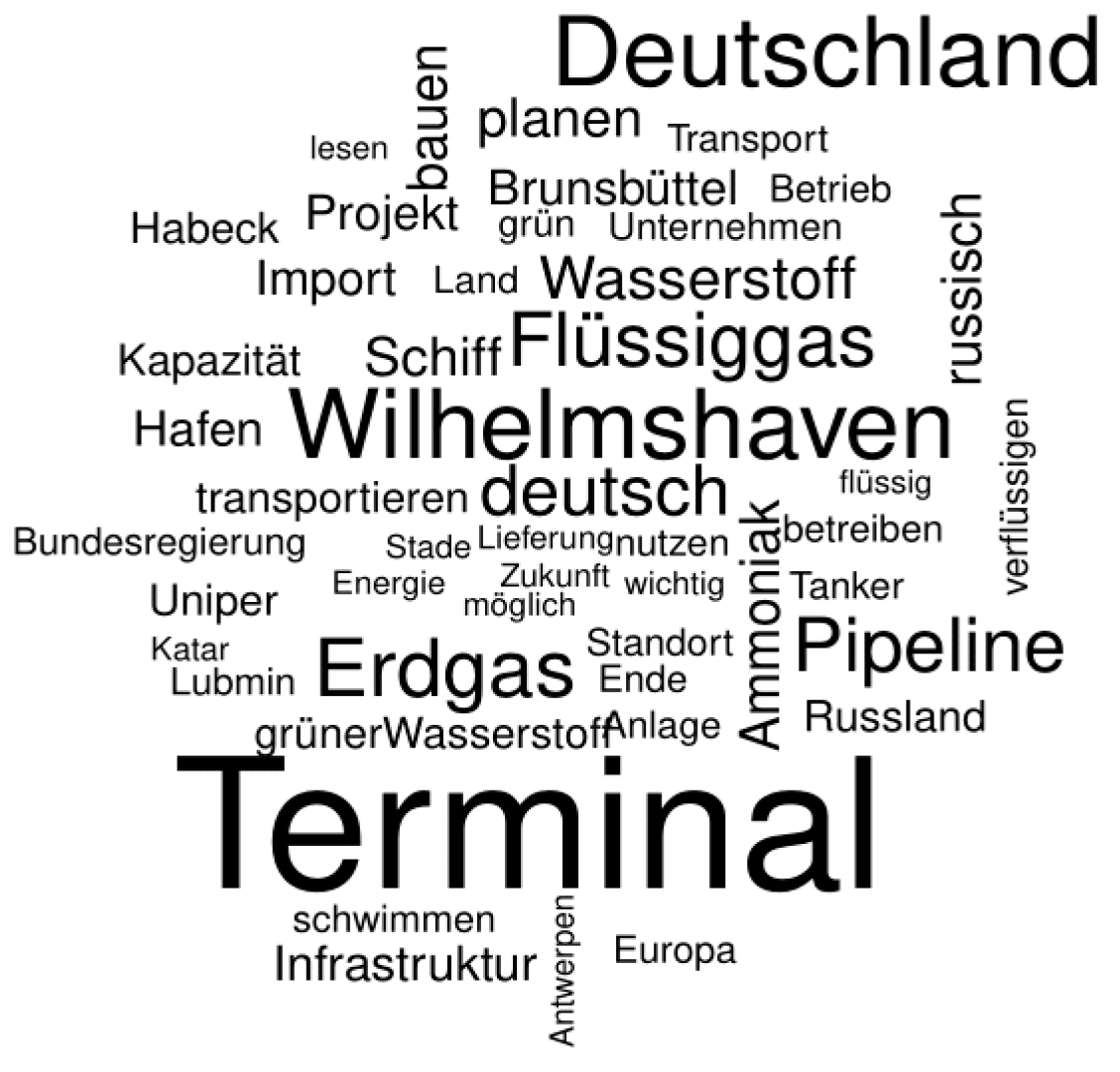
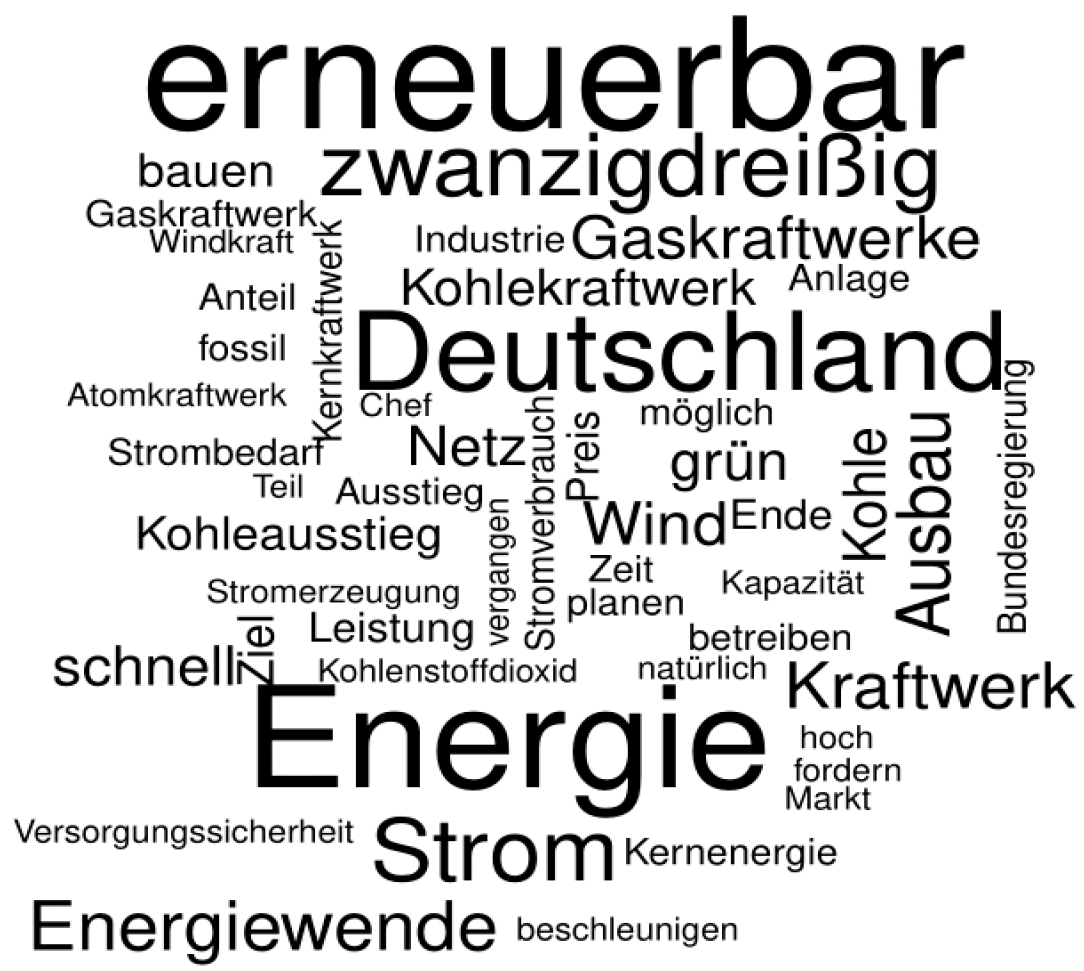
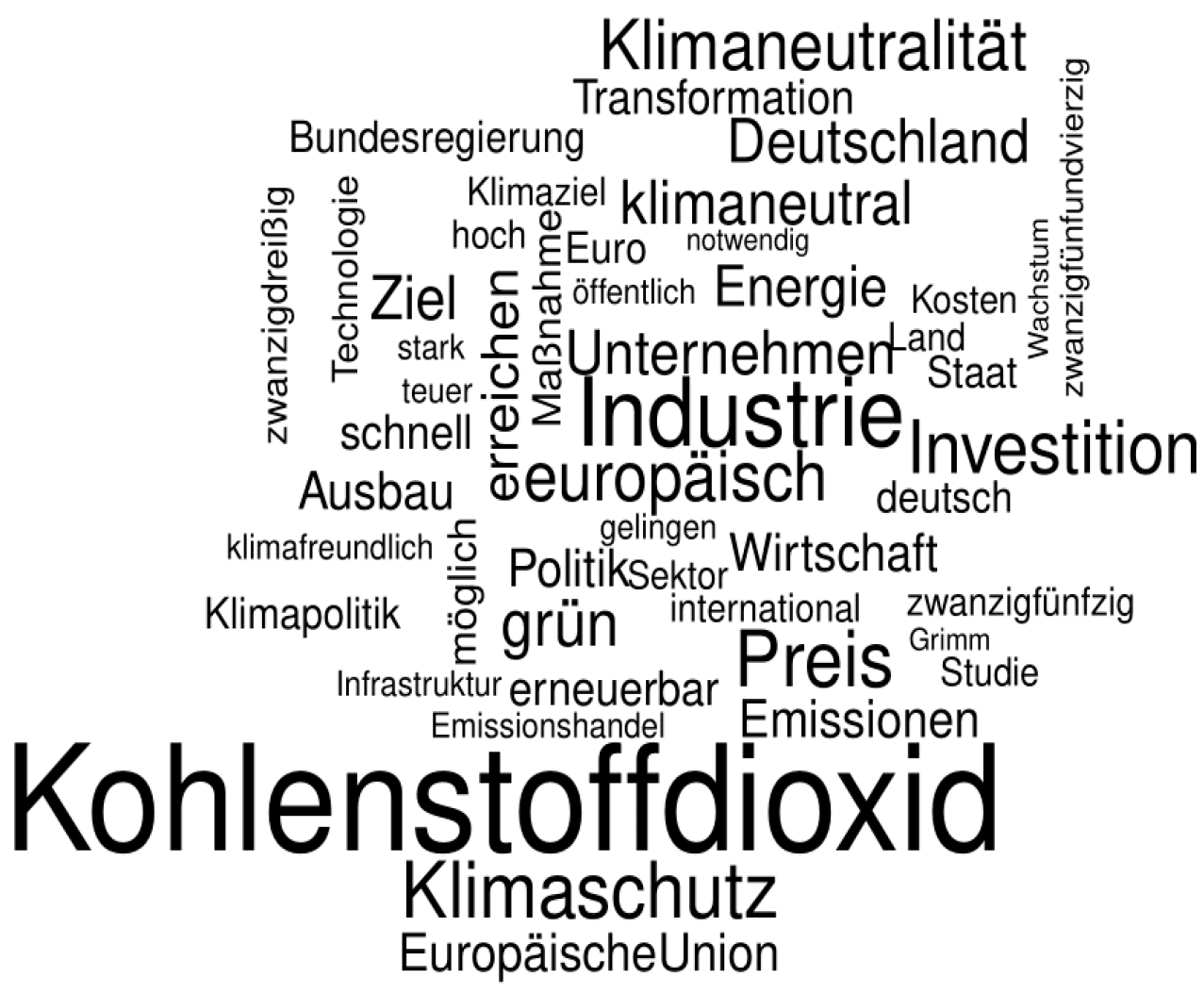
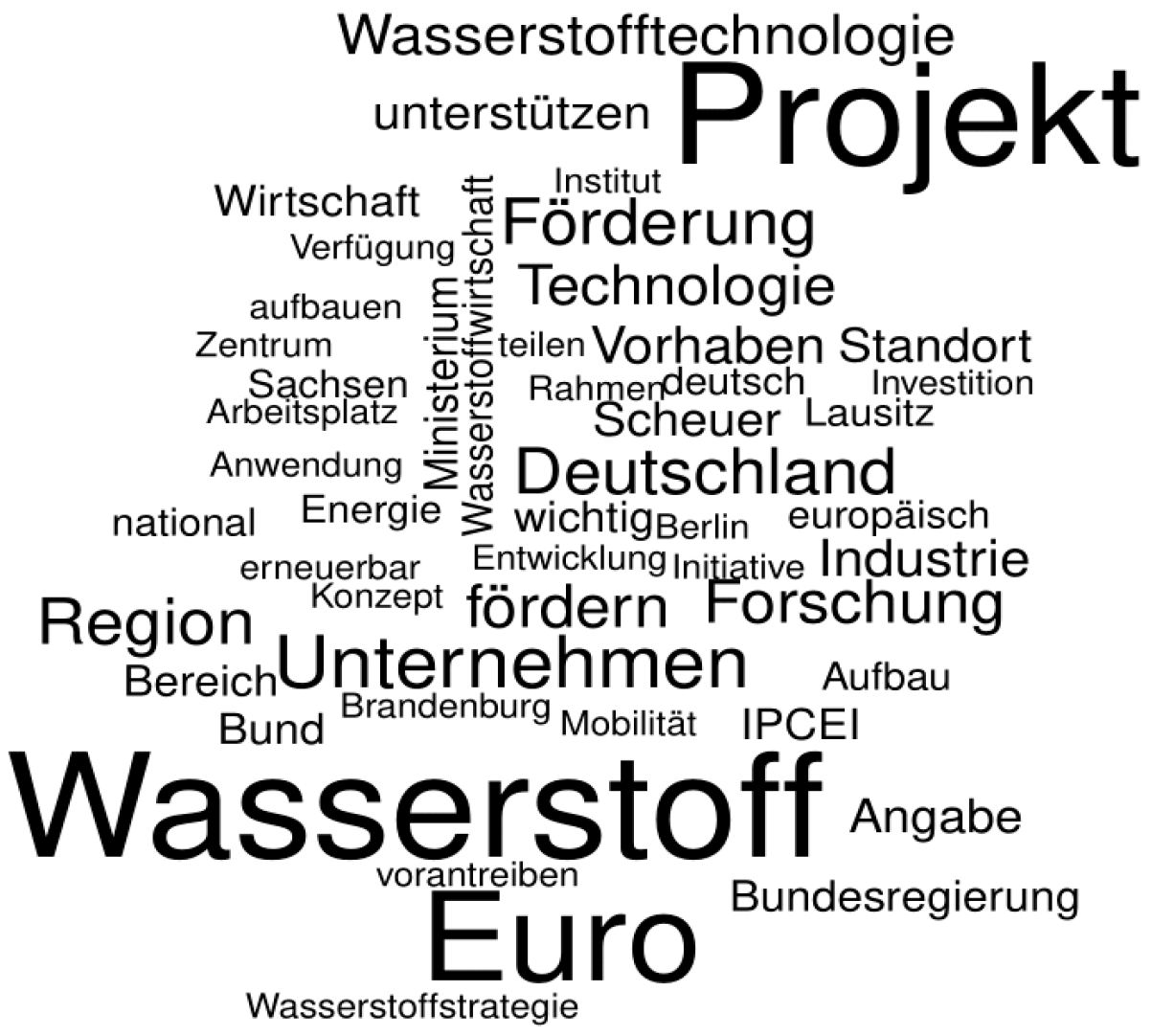


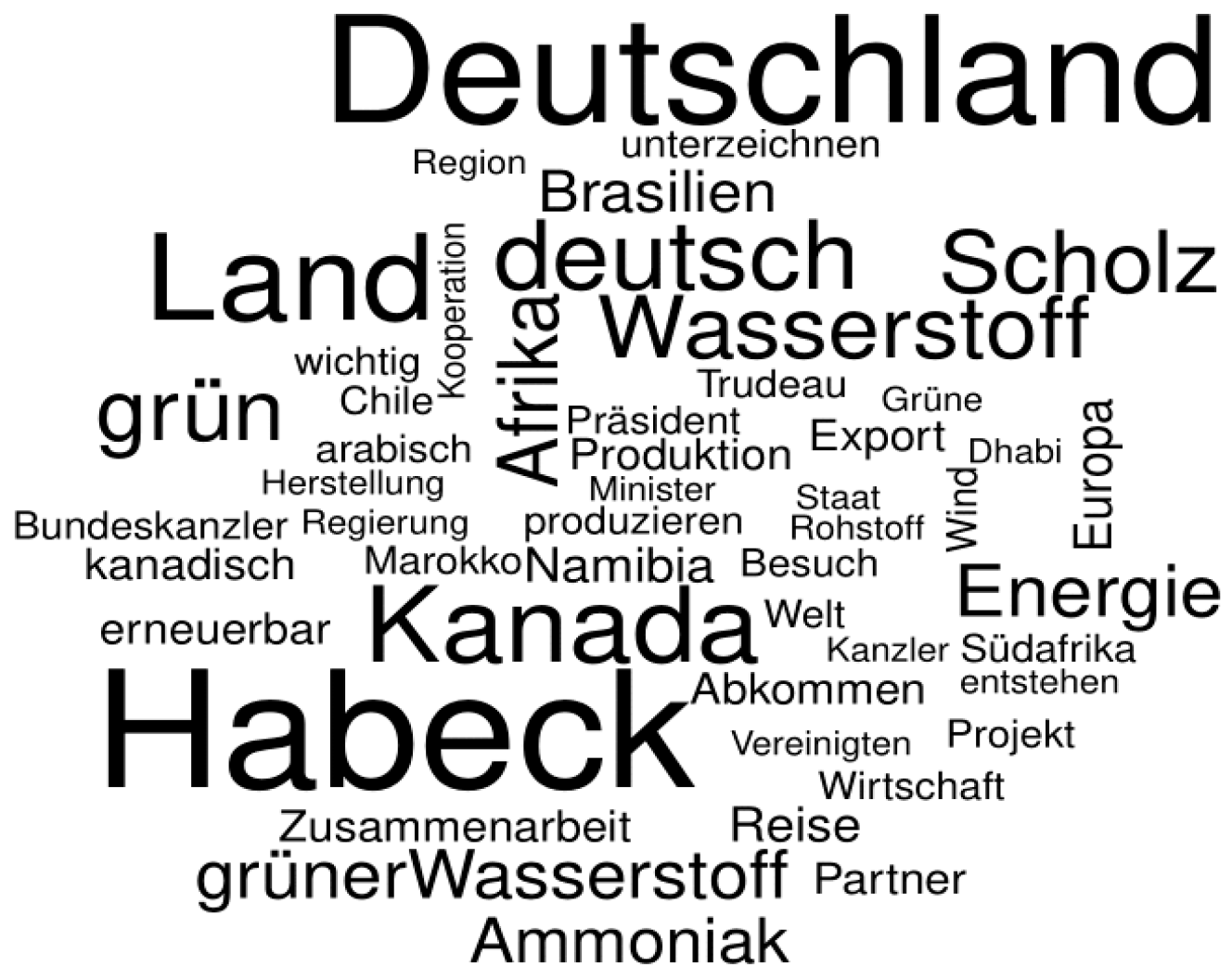

Appendix B

References
- Löhr, M.; Markard, J.; Ohlendorf, N. (Un)usual actor coalitions in a nascent policy subsystem: The case of hydrogen in Germany. In Proceedings of the ECPR General Conference 2021, Panel “The Rise of Hydrogen Politics: Strategies–Conflicts–Cooperation”, Virtual Event, 30 August–3 September 2021. [Google Scholar]
- Belova, A.; Quittkat, C.; Lehotský, L.; Knodt, M.; Osička, J.; Kemmerzell, J. The more the merrier? Actors and ideas in the evolution of German hydrogen policy discourse. Energy Res. Soc. Sci. 2023, 97, 102965. [Google Scholar] [CrossRef]
- Goldthau, A.C.; Youngs, R. The EU Energy Crisis and a New Geopolitics of Climate Transition. J. Common Mark. Stud. (JCMS) 2023, 61, 115–124. [Google Scholar] [CrossRef]
- Knodt, M.; Ringel, M. Energiesicherheit-Nachhaltigkeit-Nexus in Zeiten des Krieges: Krisengesteuerte Notfallmaßnahmen für den Green Deal? Integration 2023, 46, 282–289. [Google Scholar] [CrossRef]
- Knodt, M.; Ringel, M.; Bruch, N. Secure and Sustainable? Unveiling the Impact of the Russian War on EU energy governance. In The War against Ukraine and the EU: Facing New Realities; Wiesner, C., Knodt, M., Eds.; Palgrave/Macmillan: London, UK, 2024. [Google Scholar]
- Roberts, M.E.; Stewart, B.M.; Tingley, D.; Lucas, C.; Leder-Luis, J.; Gadarian, S.K.; Albertson, B.; Rand, D.G. Structural Topic Models for Open-Ended Survey Responses. Am. J. Political Sci. 2014, 58, 1064–1082. [Google Scholar] [CrossRef]
- Oliveira, A.M.; Beswick, R.R.; Yan, Y. A green hydrogen economy for a renewable energy society. Curr. Opin. Chem. Eng. 2021, 33, 100701. [Google Scholar] [CrossRef]
- Hanley, E.S.; Deane, J.P.; Gallachóir, B.Ó.P. The role of hydrogen in low carbon energy futures–A review of existing perspectives. Renew. Sustain. Energy Rev. 2018, 82, 3027–3045. [Google Scholar] [CrossRef]
- Kovač, A.; Paranos, M.; Marciuš, D. Hydrogen in energy transition: A review. Int. J. Hydrogen Energy 2021, 46, 10016–10035. [Google Scholar] [CrossRef]
- Gils, H.C.; Gardian, H.; Schmugge, J. Interaction of hydrogen infrastructures with other sector coupling options towards a zero-emission energy system in Germany. Renew. Energy 2021, 180, 140–156. [Google Scholar] [CrossRef]
- Welder, L.; Ryberg, D.; Kotzur, L.; Grube, T.; Robinius, M.; Stolten, D. Spatio-temporal optimization of a future energy system for power-to-hydrogen applications in Germany. Energy 2018, 158, 1130–1149. [Google Scholar] [CrossRef]
- Kruse, M.; Wedemeier, J. Potenzial grüner Wasserstoff: Langer Weg der Entwicklung, kurze Zeit bis zur Umsetzung. Wirtschaftsdienst 2021, 101, 26–32. [Google Scholar] [CrossRef]
- Heinz, B.; Erdmann, G. Dynamic effects on the acceptance of hydrogen technologies—An international comparison. Int. J. Hydrogen Energy 2008, 33, 3004–3008. [Google Scholar] [CrossRef]
- Schmidt, A.; Donsbach, W. Acceptance factors of hydrogen and their use by relevant stakeholders and the media. Int. J. Hydrogen Energy 2016, 41, 4509–4520. [Google Scholar] [CrossRef]
- Schlund, D.; Schulte, S.; Sprenger, T. The Who’s Who of a Hydrogen Market Ramp-Up: A Stakeholder Analysis for Germany; EWI Working Paper; Energiewirtschaftliche Institut an der Universität zu Köln (EWI): Köln, Germany, 2021. [Google Scholar]
- Ohlendorf, N.; Löhr, M.; Markard, J. Actors in multi-sector transitions—Discourse analysis on hydrogen in Germany. Environ. Innov. Soc. Transit. 2023, 47, 100692. [Google Scholar] [CrossRef]
- Zimmer, R.; Welke, J. Let’s go green with hydrogen! The general public’s perspective. Int. J. Hydrogen Energy 2012, 37, 17502–17508. [Google Scholar] [CrossRef]
- Zimmer, R.; Jänsch, M. Diskursanalyse der Mediendebatte zur Wasserstoffmobilität. Available online: https://www.now-gmbh.de/wp-content/uploads/2020/09/ht-ab-04_medienanalyse.pdf (accessed on 29 November 2022).
- Grubb, M.; Drummond, P.; Poncia, A.; McDowall, W.; Popp, D.; Samadi, S.; Penasco, C.; Gillingham, K.T.; Smulders, S.; Glachant, M.; et al. Induced innovation in energy technologies and systems: A review of evidence and potential implications for CO2 mitigation. Environ. Res. Lett. 2021, 16, 43007. [Google Scholar] [CrossRef]
- Zetterberg, L.; Johnsson, F.; Elkerbout, M. Impacts of the Russian Invasion of Ukraine on the Planned Green Transformation in Europe. Available online: https://www.ivl.se/download/18.147c3211181202f18d11ca4e/1657867472879/Ukraine%20PolicyBrief_6%20July%202022.pdf (accessed on 13 October 2023).
- Osička, J.; Černoch, F. European energy politics after Ukraine: The road ahead. Energy Res. Soc. Sci. 2022, 91, 102757. [Google Scholar] [CrossRef]
- Kuzemko, C.; Blondeel, M.; Dupont, C.; Brisbois, M.C. Russia’s war on Ukraine, European energy policy responses & implications for sustainable transformations. Energy Res. Soc. Sci. 2022, 93, 102842. [Google Scholar] [CrossRef]
- Bundesnetzagentur. Pressemitteilung vom 06.01.2023: Bundesnetzagentur Veröffentlicht Zahlen zur Gasversorgung 2022. Available online: https://www.bundesnetzagentur.de/SharedDocs/Pressemitteilungen/DE/2023/20230106_RueckblickGasversorgung.html (accessed on 16 October 2023).
- Wiertz, T.; Mattissek, A.; Kuhn, L. A turn to geopolitics: How Russia’s war against Ukraine unsettles the German energy transition discourse. Energy Res. Soc. Sci. 2022, 98, 103036. [Google Scholar] [CrossRef]
- European Commission. In Focus: Renewable Hydrogen to Decarbonise the EU’s Energy System. Available online: https://commission.europa.eu/news/focus-renewable-hydrogen-decarbonise-eus-energy-system-2022-11-15-0_en (accessed on 22 October 2023).
- Atzler, F.; Türck, J.; Türck, R.; Krahl, J. The Energy Situation in the Federal Republic of Germany: Analysis of the Current Situation and Perspectives for a Non-Fossil Energy Supply. Energies 2023, 16, 4569. [Google Scholar] [CrossRef]
- Carlson, E.L.; Pickford, K.; Nyga-Lukaszewska, H. Green hydrogen and an evolving concept of energy security: Challenges and comparisons. Renew. Energy 2023, 219, 119410. [Google Scholar] [CrossRef]
- Skalamera, M. The Geopolitics of Energy after the Invasion of Ukraine. Wash. Q. 2023, 46, 7–24. [Google Scholar] [CrossRef]
- Giuli, M.; Oberthür, S. Third time lucky? Reconciling EU climate and external energy policy during energy security crises. J. Eur. Integr. 2023, 45, 395–412. [Google Scholar] [CrossRef]
- OECD. Digital Transformation in the Age of COVID-19: Building Resilience and Bridging Divides, Digital Economy; Outlook 2020 Supplement Paris; OECD: Paris, France, 2020. [Google Scholar]
- McQuail, D.; Deuze, M. McQuail’s Media and Mass Communication Theory, 7th ed.; SAGE: New York, NY, USA, 2020; ISBN 978-1-47-390251-0. [Google Scholar]
- Lehotský, L.; Černoch, F.; Osička, J.; Ocelík, P. When climate change is missing: Media discourse on coal mining in the Czech Republic. Energy Policy 2019, 129, 774–786. [Google Scholar] [CrossRef]
- Cox, J.R.; Pezzullo, P.C. Environmental Communication and the Public Sphere, 4th ed.; SAGE: Los Angeles, CA, USA, 2016. [Google Scholar]
- Früh, W. Inhaltsanalyse: Theorie und Praxis, 4th ed.; Überarbeitete Auflage; UVK Medien: Konstanz, Germany, 1998; ISBN 3896692437. [Google Scholar]
- Leifeld, P. Reconceptualizing Major Policy Change in the Advocacy Coalition Framework: A Discourse Network Analysis of German Pension Politics. Policy Stud. J. 2013, 41, 169–198. [Google Scholar] [CrossRef]
- Roberts, M.E.; Stewart, B.M.; Tingley, D. Navigating the local modes of big data: The case of topic models. In Computational Social Science: Discovery and Prediction; Alvarez, R.M., Ed.; Cambridge University Press: Cambridge, MA, USA, 2016; pp. 51–97. ISBN 978-1-31-625734-0. [Google Scholar]
- Roberts, M.E.; Stewart, B.M.; Airoldi, E.M. A Model of Text for Experimentation in the Social Sciences. J. Am. Stat. Assoc. 2016, 111, 988–1003. [Google Scholar] [CrossRef]
- Dehler-Holland, J.; Okoh, M.; Keles, D. Assessing technology legitimacy with topic models and sentiment analysis—The case of wind power in Germany. Technol. Forecast. Soc. Chang. 2022, 175, 121354. [Google Scholar] [CrossRef]
- Blei, D.M.; Ng, A.Y.; Jordan, M.I. Latent dirichlet allocation. J. Mach. Learn. Res. 2003, 3, 993–1022. [Google Scholar]
- Blei, D.M.; Lafferty, J.D. A correlated topic model of Science. Ann. Appl. Stat. 2007, 1, 17–35. [Google Scholar] [CrossRef]
- Roberts, M.E.; Stewart, B.M.; Tingley, D. Stm: An R Package for Structural Topic Models. J. Stat. Soft. 2019, 91, 1–40. [Google Scholar] [CrossRef]
- de Jong, M. Tracing the downfall of the Nord Stream 2 gas pipeline. WIREs Energy Environ. 2023, e502. [Google Scholar] [CrossRef]
- Pepe, J.M. Der Ukraine-Krieg und Seine Folgen: Deutschland Muss Seine Energietransformation Neu Austarieren; SWP—Kurz Gesagt: Berlin, Germany, 2022. [Google Scholar]
- Lambert, L.A.; Tayah, J.; Lee-Schmid, C.; Abdalla, M.; Abdallah, I.; Ali, A.H.; Esmail, S.; Ahmed, W. The EU’s natural gas Cold War and diversification challenges. Energy Strategy Rev. 2022, 43, 100934. [Google Scholar] [CrossRef]
- Halser, C.; Paraschiv, F. Pathways to Overcoming Natural Gas Dependency on Russia—The German Case. Energies 2022, 15, 4939. [Google Scholar] [CrossRef]
- Wang, F.; Swinbourn, R.; Li, C. Shipping Australian sunshine: Liquid renewable green fuel export. Int. J. Hydrogen Energy 2023, 48, 14763–14784. [Google Scholar] [CrossRef]
- acatech; BDI. HySupply: A Meta-Analysis towards a German-Australian Supply-Chain for Renewable Hydrogen. Available online: https://en.acatech.de/wp-content/uploads/sites/6/2020/11/HySupply_WorkingPaper_Meta-Analysis.pdf (accessed on 18 October 2023).
- Lebrouhi, B.E.; Djoupo, J.J.; Lamrani, B.; Benabdelaziz, K.; Kousksou, T. Global hydrogen development—A technological and geopolitical overview. Int. J. Hydrogen Energy 2022, 47, 7016–7048. [Google Scholar] [CrossRef]
- Dolata, P. Canada, the EU and energy security: A historical perspective. Can. Foreign Policy J. 2022, 28, 216–233. [Google Scholar] [CrossRef]
- Nunez, A.; Quitzow, R. Germany’s Hydrogen Strategy: Securing Industrial Leadership in a Carbon-Neutral Economy. Available online: https://www.rifs-potsdam.de/de/ergebnisse/publikationen/2023/germanys-hydrogen-strategy-securing-industrial-leadership-carbon (accessed on 23 October 2023).
- Quitzow, R.; Nunez, A.; Marian, A. Positioning Germany in an International Hydrogen Economy: A Policy Review. Available online: https://papers.ssrn.com/sol3/papers.cfm?abstract_id=4441760 (accessed on 23 October 2023).
- Jahn, J.; Caspar, O.; Quitzow, R.; Thielges, S.; Wiesholzer, A. Wasserstoff: Eine zukunftsfähige Option für die Energiebeziehungen Zwischen der EU und Russland? Available online: https://www.iass-potsdam.de/de/blog/2021/01/wasserstoff-eine-zukunftsfaehige-option-fuer-die-energiebeziehungen-zwischen-der-eu (accessed on 19 June 2023).
- Proedrou, F. EU Decarbonization under Geopolitical Pressure: Changing Paradigms and Implications for Energy and Climate Policy. Sustainability 2023, 15, 5083. [Google Scholar] [CrossRef]
- Riemer, M.; Schreiner, F.; Wachsmut, J. Conversion of LNG Terminals for Liquid Hydrogen or Ammonia. Analysis of Technical Feasibility und Economic Considerations. Available online: https://www.isi.fraunhofer.de/content/dam/isi/dokumente/cce/2022/Report_Conversion_of_LNG_Terminals_for_Liquid_Hydrogen_or_Ammonia.pdf (accessed on 23 October 2023).
- Plank, F.; Muntschick, J.; Niemann, A.; Knodt, M. External Hydrogen Relations of the European Union: Framing Processes in the Public Discourse towards and within Partner Countries. Sustainability 2023, 15, 14757. [Google Scholar] [CrossRef]

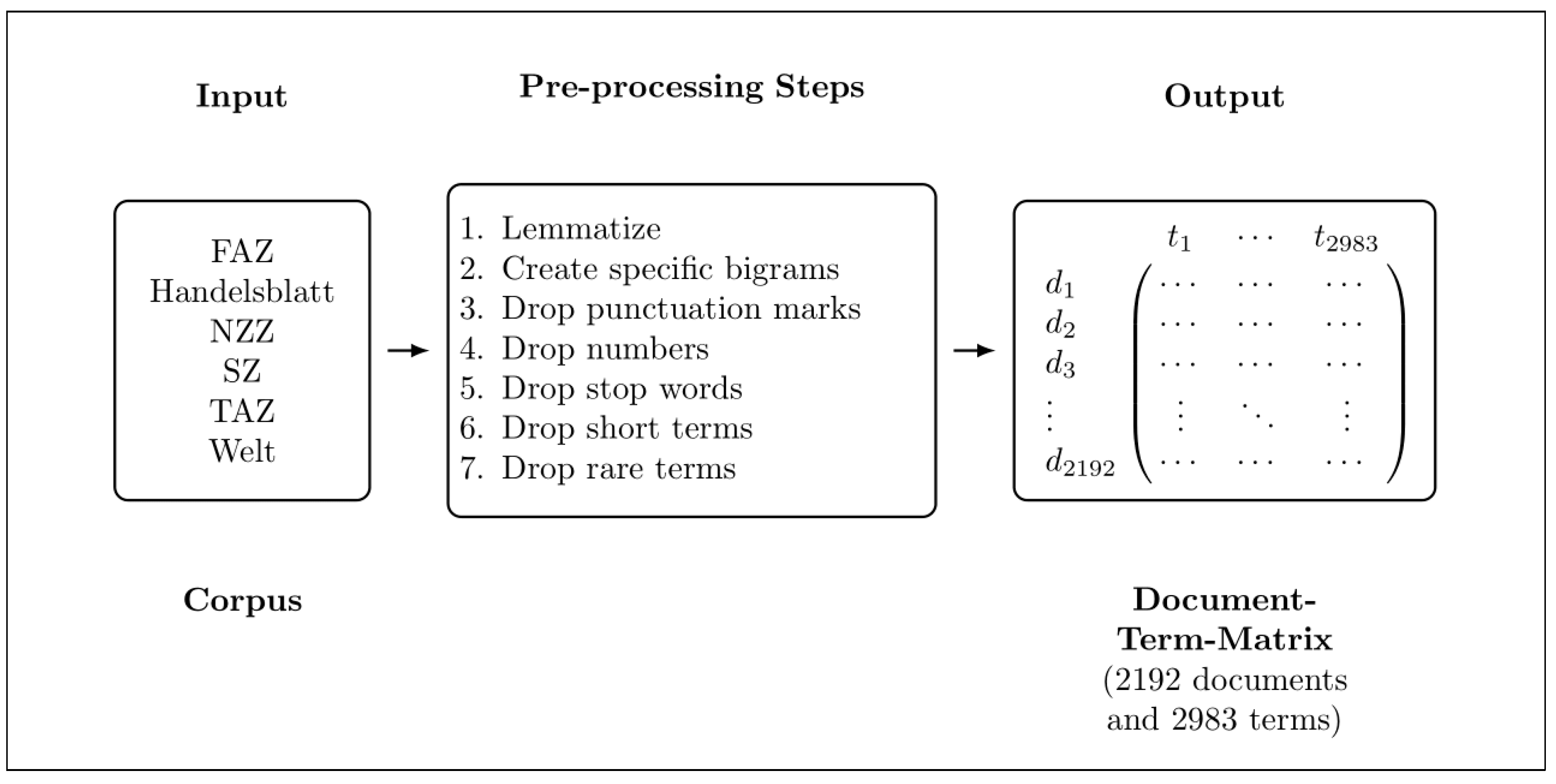

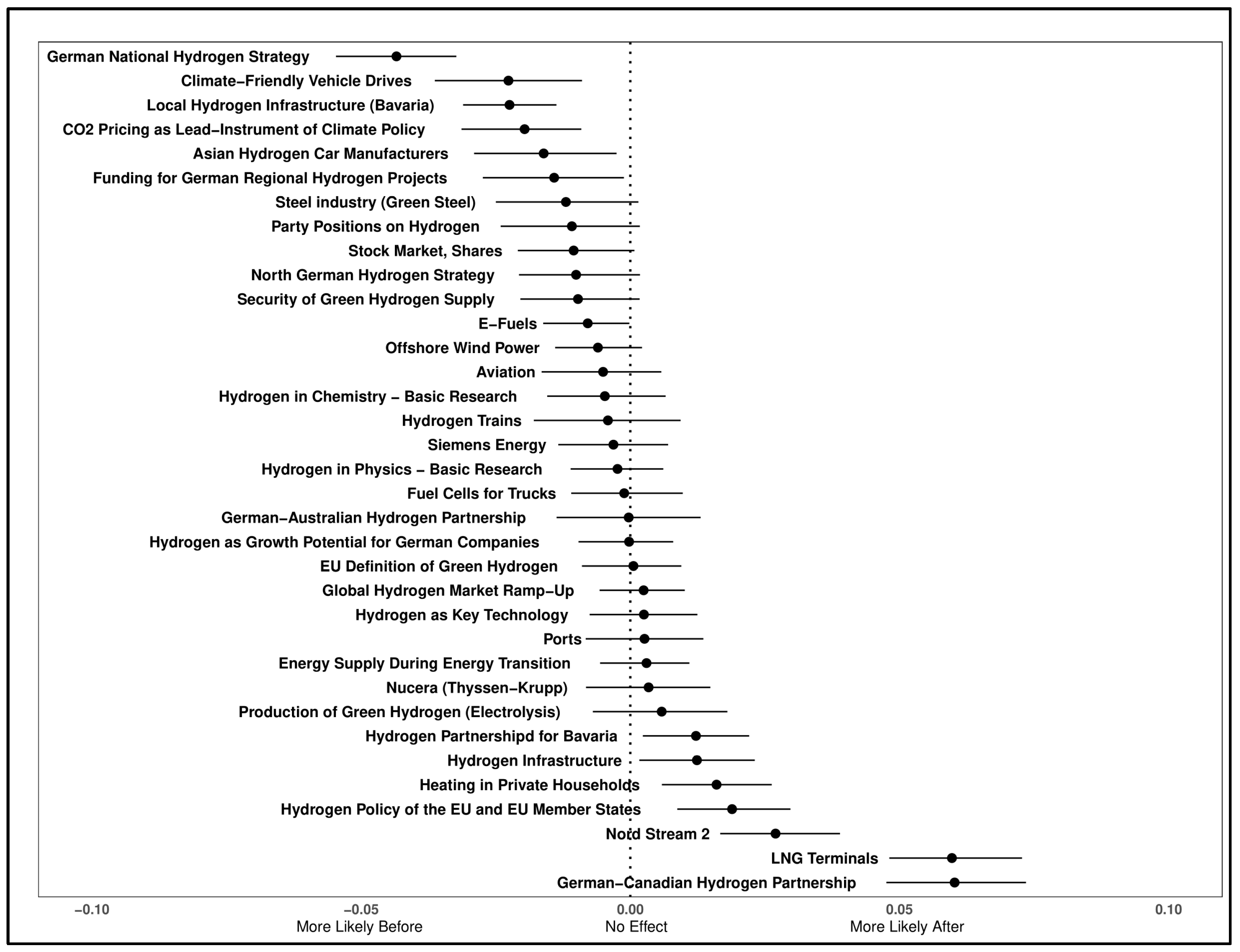
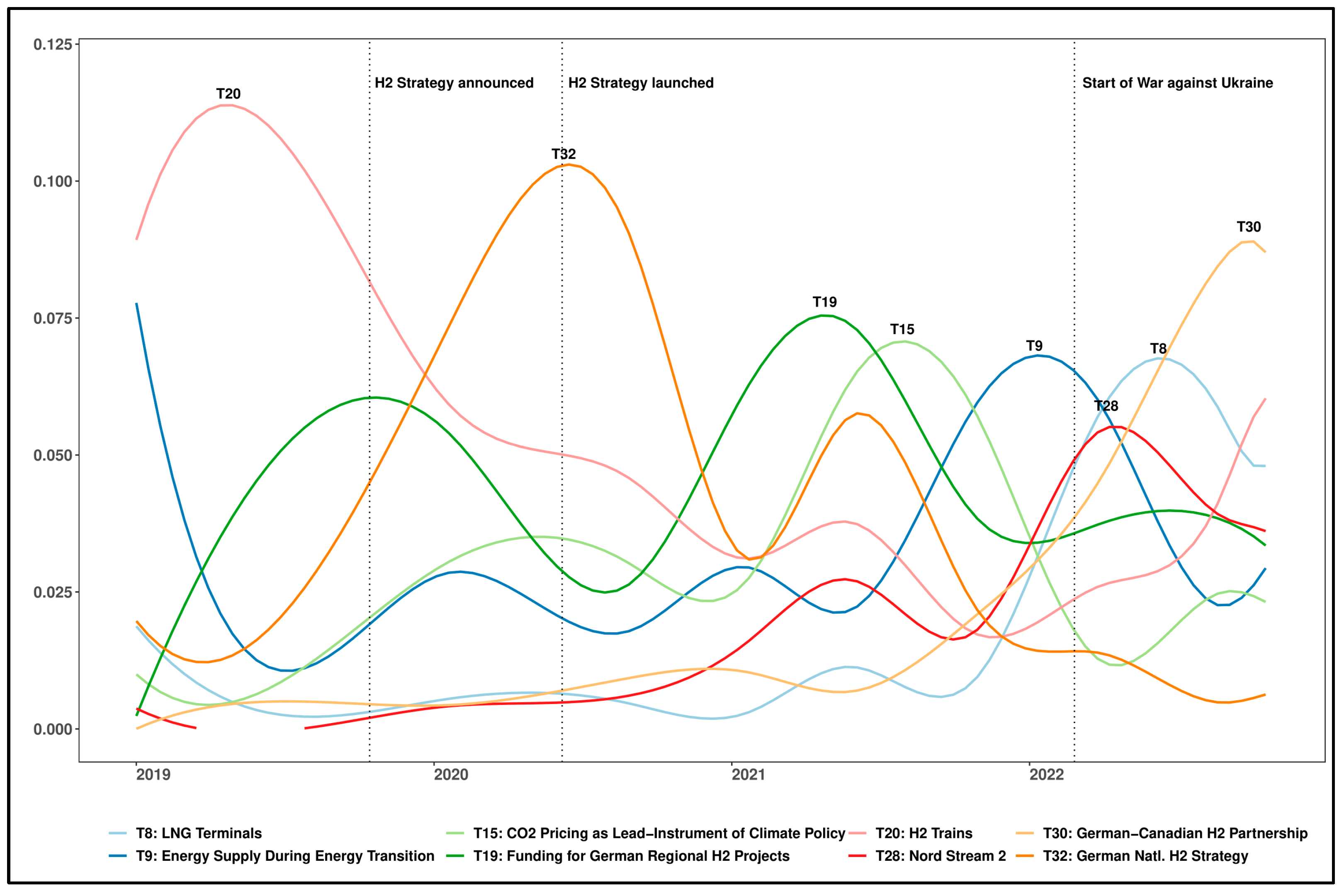
| Topic Label | # | Top Words | Proportion |
|---|---|---|---|
| Security of Green Hydrogen Supply | 11 | Wasserstoff, Energie, Deutschland, erneuerbar, Strom, Energieträger | 0.0651 |
| Production of Green Hydrogen (Electrolysis) | 13 | Wasserstoff, Anlage, grünerWasserstoff, Strom, grün, Elektrolyse | 0.0531 |
| North German Hydrogen Strategy | 27 | Wasserstoff, Land, Bund, Energie, grün, Niedersachsen | 0.0490 |
| Funding for German Regional Hydrogen Projects | 19 | Wasserstoff, Projekt, Euro, Unternehmen, Region, Deutschland | 0.0488 |
| Hydrogen Trains | 20 | Wasserstoff, Brennstoffzelle, Tankstelle, Strecke, Batterie, Fahrzeug | 0.0456 |
| German National Hydrogen Strategy | 32 | Bundesregierung, grünerWasserstoff, Wasserstoff, Wasserstoffstrategie, erneuerbar, national | 0.0389 |
| Steel Industry (Green Steel) | 34 | Stahl, Kohlenstoffdioxid, ThyssenKrupp, Stahlindustrie, grün, Wasserstoff | 0.0373 |
| Hydrogen in Chemistry | 26 | Wasserstoff, Wasser, Forscher, chemisch, entstehen, nutzen | 0.0357 |
| CO2 Pricing as Lead-Instrument of Climate Policy | 15 | Kohlenstoffdioxid, Industrie, Preis, Klimaschutz, Investition, Klimaneutralität | 0.0337 |
| Energy Supply During Energy Transition | 9 | erneuerbar, Energie, Deutschland, zwanzigdreißig, Strom, Ausbau | 0.0335 |
| Party Positions on Hydrogen | 33 | Deutschland, Mensch, Frage, deutsch, Union, Land | 0.0320 |
| Asian Hydrogen Car Manufacturers | 25 | Brennstoffzelle, Wasserstoff, Toyota, Auto, Fahrzeug, Hyundai | 0.0304 |
| Local Hydrogen Infrastructure (Bavaria) | 10 | Landkreis, Wasserstoff, München, Ebersberg, Landshut, Tankstelle | 0.0298 |
| Fuel Cells for Trucks | 31 | Daimler, Brennstoffzelle, Truck, Lastwagen, Wasserstoff, Batterie | 0.0296 |
| Hydrogen Policy of the EU and EU Member States | 16 | EuropäischeUnion, Kommission, Europa, europäisch, Spanien, Frankreich | 0.0268 |
| Climate-Friendly Vehicle Drives | 23 | Auto, Batterie, Elektroauto, Fahrzeug, Verbrennungsmotor, Mobilität | 0.0266 |
| EU Definition of Green Hydrogen | 14 | Kohlenstoffdioxid, Wasserstoff, Erdgas, blauerWasserstoff, herstellen, Emissionen | 0.0264 |
| German-Canadian Hydrogen Partnership | 30 | Habeck, Deutschland, Land, Kanada, deutsch, Scholz | 0.0263 |
| German Australian Hydrogen Partnership | 1 | Wasserstoff, grünerWasserstoff, Deutschland, Unternehmen, deutsch, Australien | 0.0245 |
| Heating in Private Households | 6 | Wärmepumpe, Strom, Gebäude, Haus, heizen, Energie | 0.0234 |
| Hydrogen Infrastructure | 2 | Wasserstoff, Netz, Erdgas, Wasserstoffnetz, Gasnetz, Netzbetreiber | 0.0230 |
| LNG Terminals | 8 | Terminal, Deutschland, Wilhelmshaven, Erdgas, Flüssiggas, Pipeline | 0.0218 |
| Aviation | 29 | Wasserstoff, Airbus, Flugzeug, Luftfahrt, Kerosin, fliegen | 0.0216 |
| Nucera (Thyssen-Krupp) | 22 | Euro, Konzern, Uniper, Unternehmen, ThyssenKrupp, Wasserstoff | 0.0211 |
| Nord Stream 2 | 28 | Russland, Ukraine, russisch, Europa, NordStream, Deutschland | 0.0210 |
| Stock Market, Shares | 17 | Bosch, Aktie, Wasserstoff, Unternehmen, Dollar, Euro | 0.0209 |
| Hydrogen as Key Technology | 35 | China, Europa, Unternehmen, Technologie, Welt, Markt | 0.0202 |
| E-Fuels | 3 | Kraftstoff, synthetisch, EFuels, Kohlenstoffdioxid, klimaneutral, Treibstoff | 0.0201 |
| Hydrogen Partnerships for Bavaria | 5 | Bayern, Wasserstoff, Söder, Aiwanger, bayerisch, Energie | 0.0191 |
| Global Hydrogen Market Ramp-Up | 7 | Japan, Land, Wasserstoff, Regierung, Australien, Energie | 0.0189 |
| Offshore Wind Power | 18 | Offshore, Windpark, Projekt, Land, Windrad, Windkraft | 0.0186 |
| Hydrogen in Physics | 12 | Energie, Technologie, Fusion, Element, Neutrino, Wasserstoff | 0.0152 |
| Ports | 24 | Hamburg, Hafen, Bremen, Stadt, Wasserstoff, Standort | 0.0150 |
| Siemens Energy | 21 | Siemens, Energy, Wasserstoff, Konzern, Chef, Görlitz | 0.0142 |
| Hydrogen as Growth Potential for German Companies | 4 | Unternehmen, Start, Linde, Konzern, deutsch, Firma | 0.0127 |
Disclaimer/Publisher’s Note: The statements, opinions and data contained in all publications are solely those of the individual author(s) and contributor(s) and not of MDPI and/or the editor(s). MDPI and/or the editor(s) disclaim responsibility for any injury to people or property resulting from any ideas, methods, instructions or products referred to in the content. |
© 2024 by the authors. Licensee MDPI, Basel, Switzerland. This article is an open access article distributed under the terms and conditions of the Creative Commons Attribution (CC BY) license (https://creativecommons.org/licenses/by/4.0/).
Share and Cite
Loewe, M.; Quittkat, C.; Knodt, M.; Ott, I. The Impact of the Russian War against Ukraine on the German Hydrogen Discourse. Sustainability 2024, 16, 773. https://doi.org/10.3390/su16020773
Loewe M, Quittkat C, Knodt M, Ott I. The Impact of the Russian War against Ukraine on the German Hydrogen Discourse. Sustainability. 2024; 16(2):773. https://doi.org/10.3390/su16020773
Chicago/Turabian StyleLoewe, Martha, Christine Quittkat, Michèle Knodt, and Ingrid Ott. 2024. "The Impact of the Russian War against Ukraine on the German Hydrogen Discourse" Sustainability 16, no. 2: 773. https://doi.org/10.3390/su16020773
APA StyleLoewe, M., Quittkat, C., Knodt, M., & Ott, I. (2024). The Impact of the Russian War against Ukraine on the German Hydrogen Discourse. Sustainability, 16(2), 773. https://doi.org/10.3390/su16020773






